History of Aviation
[audio:https://aviationenglishblog.com/wp-content/uploads/2010/09/09historyofaviation.mp3|titles=The History of Aviation]TOPIC: History of Aviation
GOAL: To learn about the origins of manned flight and its fascinating history
Level: Easy
Exercise #1: Read about the history of aviation and then proceed to Exercise #2
While many aviation professionals and enthusiasts recognize the beginnings of manned flight with the Wright Brothers or Santos Dumont, its origins really stretch well before those dates in aeronautical history. In fact, famous inventors such as Leonardo da Vinci, John Stringfellow and Lawrence Hargrave had conjured up ideas of how to get some of the strangest machines to fly long before the Wright brothers' famous first flight at Kitty Hawk.
The kite was the first form of an aircraft believed to have been first designed in the 5th century BC. Roger Bacon, an English monk, performed studies later on in the 13th century which gave him the idea that air could support a craft just like water supports boats. In the 16th century, Leonardo da Vinci studied birds’ flight and later produced the airscrew and the parachute. The airscrew, leading to the propeller later on and the parachute were tremendously important contributions to aviation. He envisioned three different types of heavier-than-air craft; the helicopter, glider and ornithopter (a machine with mechanical wings which flaps to mimic a bird).
 Some of the more credible developments in actual flight and stability occurred in the 19th century. Sir George Cayley of Britain designed a combined helicopter and horizontally propelled aircraft and the British Francis Herbert Wenham used wind tunnels in his studies. He also predicted the application of multiple wings placed above each other. Another famous inventor was John Stringfellow, who designed a steam engine powered aircraft which was launched from a wire. This model demonstrated lift but failed to actually climb. Lawrence Hargrave, a British-born Australian inventor, created a rigid-wing aircraft with flapping blades operated by a compressed-air motor, it flew 312 ft (95m) in 1891.
Some of the more credible developments in actual flight and stability occurred in the 19th century. Sir George Cayley of Britain designed a combined helicopter and horizontally propelled aircraft and the British Francis Herbert Wenham used wind tunnels in his studies. He also predicted the application of multiple wings placed above each other. Another famous inventor was John Stringfellow, who designed a steam engine powered aircraft which was launched from a wire. This model demonstrated lift but failed to actually climb. Lawrence Hargrave, a British-born Australian inventor, created a rigid-wing aircraft with flapping blades operated by a compressed-air motor, it flew 312 ft (95m) in 1891.
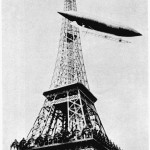 Jean Marie Le Bris of France was a famous glider developer in the 19th century who tested a glider with movable wings. Kites also played an important role in the development of aviation, they could be used to test aerodynamics and flight stability. Lawrence Hargrave first created the box kite in 1893 and Alexander Graham Bell developed a gigantic passenger-carrying tetrahedral-celled kite from 1895 to 1910. Some of the most important full-scale model flight attempts were made by Samuel Langley, who created the first heavier-than-air, gasoline-powered engine which actually flew. The 'aerodrome', which he called it, was powered by a 53 horsepower 5-cylinder radial engine and later crashed into Washington DC’s Potomac River on December 1903 — days before the Wright's historic flight.
Jean Marie Le Bris of France was a famous glider developer in the 19th century who tested a glider with movable wings. Kites also played an important role in the development of aviation, they could be used to test aerodynamics and flight stability. Lawrence Hargrave first created the box kite in 1893 and Alexander Graham Bell developed a gigantic passenger-carrying tetrahedral-celled kite from 1895 to 1910. Some of the most important full-scale model flight attempts were made by Samuel Langley, who created the first heavier-than-air, gasoline-powered engine which actually flew. The 'aerodrome', which he called it, was powered by a 53 horsepower 5-cylinder radial engine and later crashed into Washington DC’s Potomac River on December 1903 — days before the Wright's historic flight.
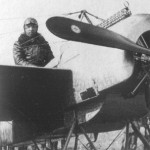 Before World War I, airplane design greatly improved. Pusher biplanes (two-winged airplanes with the engine and propeller behind the wing) were succeeded by tractor biplanes (two-winged airplanes with the engine and propeller in front of the wing). Monoplane designs were rare and when World War I began, huge biplane bombers with two to four engines were developed. During WWI, aviation made great leaps forward in the fields of design and manufacture of aircraft. Equally important was the experience gained by the pilots flying the early fighter craft through the aerial maneuvers required in dog fights. Manfred Von Richthofen, Eddie Rickenbacker and numerous others were so successful because they had learned to master their aircraft.
Before World War I, airplane design greatly improved. Pusher biplanes (two-winged airplanes with the engine and propeller behind the wing) were succeeded by tractor biplanes (two-winged airplanes with the engine and propeller in front of the wing). Monoplane designs were rare and when World War I began, huge biplane bombers with two to four engines were developed. During WWI, aviation made great leaps forward in the fields of design and manufacture of aircraft. Equally important was the experience gained by the pilots flying the early fighter craft through the aerial maneuvers required in dog fights. Manfred Von Richthofen, Eddie Rickenbacker and numerous others were so successful because they had learned to master their aircraft.
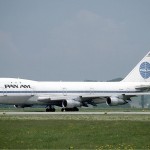 Transatlantic air travel in the immediate post-war years remained a novelty, but it offered significant advantages over sea travel. A usual journey by sea across the Atlantic took about five days, while air travel cut that down to less about half a day. Events in the post-war era also led to a rise in commercial cooperation between Western European countries and the United States, which increased tourism and made air travel easier. European airlines were in too weak a position, however, to take advantage of the new demand for transatlantic passenger travel because of their post-war equipment and aircraft shortage. Here, American air carriers, such as Pan American, AOA, and the relative newcomer TWA were able to fill the new needs. TWA joined Pan American and AOA in offering regularly scheduled transatlantic services in February 1946 using the Constellation, and quickly became a stiff competitor to the two other U.S. air carriers.
Transatlantic air travel in the immediate post-war years remained a novelty, but it offered significant advantages over sea travel. A usual journey by sea across the Atlantic took about five days, while air travel cut that down to less about half a day. Events in the post-war era also led to a rise in commercial cooperation between Western European countries and the United States, which increased tourism and made air travel easier. European airlines were in too weak a position, however, to take advantage of the new demand for transatlantic passenger travel because of their post-war equipment and aircraft shortage. Here, American air carriers, such as Pan American, AOA, and the relative newcomer TWA were able to fill the new needs. TWA joined Pan American and AOA in offering regularly scheduled transatlantic services in February 1946 using the Constellation, and quickly became a stiff competitor to the two other U.S. air carriers.
While American air services dominated transatlantic routes at the end of World War II, eventually European carriers began to take advantage of the growing market. By the end of the 1940s, Scandinavian Airlines System (SAS), Royal Dutch Airlines (KLM), Air France, the Belgian carrier SABENA, and Swissair all were carrying passengers across the Atlantic as part of a new post-war air travel boom. Where ten years previously, the transatlantic route was a rarely travelled passenger route, by 1950, it had become the world's number one route in terms of traffic and produced high revenue and fierce competition among some ten major international airlines. The Atlantic had finally been conquered for the common passenger and the jet age eventually made this crossing an ordinary trip.
Exercise #2: Watch two videos about the history of aviation, and then proceed to Exercise #3
1. An interview with Scott Crossfield – famed X-15 test pilot – who led the Wright Brothers recreation flight in 2003.
Watch Video
2. Boeing restoration crew chief Bob Bogash takes us on a tour of the prototype Boeing 727
Watch Video
3. An interview with the late Gen. Paul Tibbets who was the Captain of the famed Enola Gay B-29 that dropped the first atomic bomb on Hiroshima.
Watch Video
Exercise #3: Answer the following questions, which are based on the information contained in the text and videos you’ve just studied.
1. True or False: The Wright Brothers were the first people to fly gliders.
- True
- False
2. Who were Leonardo da Vinci, John Stringfellow and Lawrence Hargrave?
- pilots
- aircraft engineers
- inventors
- bicycle mechanics
3. ______ is a machine with mechanical wings which flaps to mimic a bird.
- ornithopter
- airplane
- aeroithopter
- airscrew
4. Who designed a combined helicopter and horizontally propelled aircraft?
- Octave Chanute
- The Wright Brothers
- John Stringfellow
- Sir George Cayley
5. ______ created the first heavier-than-air, gasoline-powered engine which actually flew.
- Samuel Langley
- Jean Marie Le Bris
- Alexander Graham Bell
- None of them
6. True or False: Monoplanes have more than one wing.
- True
- False
7. From what war were Manfred Von Richthofen and Eddie Rickenbacker from?
- Vietnam
- Korean
- World War I
- World II
8. Events in the____ era led to a rise in commercial cooperation between Western European countries and the United States.
- pre-war
- post-war
- ancient
- None of the above
Answers
1) b
2) c
3) a
4) d
5) a
6) b
7) c
8.) b











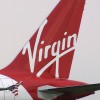



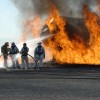
Recent Comments